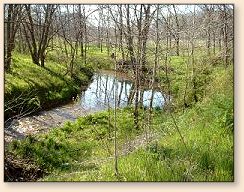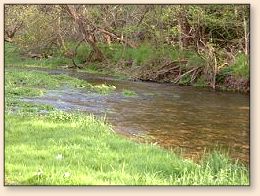 Crane Creek is a spring creek running through
the sleepy little town of Crane, Missouri, in
the heart of the Southwest Missouri dairy
country. The creek empties into the James
River, which then forms one arm of Table Rock
Lake about fifteen miles downstream. The creek
is the last refuge of pure-strain McCloud Rainbows
in the United States, and the Missouri Department
of Conservation (MDC) acquired the majority of the
riparian zone years ago for preservation purposes.
Anglers have had access via these public lands for
many years, and the fishery was highly regarded as
a rarity in the heartland of America: wild trout
in a natural spring-fed watershed. The McCloud
Rainbows were stocked by rail car once in the late
1800s, and no subsequent stockings are known to have
taken place. MDC has managed the small fishery for
years as a Wild Trout Management Area, with strict
"flies-only" and catch-and-release policies.
Crane Creek is a spring creek running through
the sleepy little town of Crane, Missouri, in
the heart of the Southwest Missouri dairy
country. The creek empties into the James
River, which then forms one arm of Table Rock
Lake about fifteen miles downstream. The creek
is the last refuge of pure-strain McCloud Rainbows
in the United States, and the Missouri Department
of Conservation (MDC) acquired the majority of the
riparian zone years ago for preservation purposes.
Anglers have had access via these public lands for
many years, and the fishery was highly regarded as
a rarity in the heartland of America: wild trout
in a natural spring-fed watershed. The McCloud
Rainbows were stocked by rail car once in the late
1800s, and no subsequent stockings are known to have
taken place. MDC has managed the small fishery for
years as a Wild Trout Management Area, with strict
"flies-only" and catch-and-release policies.
I had not fished Crane Creek for at least three
years. I began hearing disturbing stories about
how the fishery was "dead" from a few different
people scattered out here and there over the past
couple of months. When I asked one of the local
fly shop owners and fly-fishing legends about the
creek, his reply was "Crane Creek's always good."
So I decided I needed to go see for myself. And
that is precisely what I did yesterday. I packed
a 7 ˝ foot 4-weight Redington rod and reel, my waders,
my WilliamJoseph chest pack, and a digital camera
into the Jeep and pointed it toward Crane. I
arrived at the streamside parking area inside the
Wire Road Conservation Area about noon. I decided
to walk the stream for a while and just get a feel
for what kind of shape she was really in. What I
saw was not encouraging. No, it was down right
discouraging.

I'm no hydrologist, but it seems to me that the
flow rate had dropped by at least fifty percent
from what I knew to be "normal" three years ago.
Only a handful of very small fishable pools remained,
and flow was all but interrupted in several places.
The old streambed was overgrown with sedges and
other plants along most of the length of the stream,
living testament to the absence of flowing water for
quite some time. I'm also not a fisheries biologist,
but I didn't see anything along the more than two
miles of stream I inspected that looked like a
cold-water fishery. I did see some trout. I saw
one Rainbow over six inches long. I saw hundreds
of what can only be described as fry…evidence that
there are some breeders...somewhere. In one fishable
pool (the one containing the six inch fish), I wet a
line. My optimism was rewarded with the smallest
trout I have ever caught, a fish that would barely
measure three inches. The only other thing I caught
was a mild case of depression and a curiosity as to
what the experts charged with preserving this
once-robust fishery currently think and are doing
about what is obviously a distressed stream.
The moss and algae growth seemed to approach that
found in warm water streams. There was a plethora
of sculpins. Insects were hatching everywhere.
And tiny fish were frequently striking at insects
unlucky enough to hit the water. But still pools,
shallow shoals, a general lack of flow, and strong
signals of high nitrate content all seemed to spell
"trouble" to my untrained eye. Worst of all:
the utter lack of mature trout.
To me, it would be a terrible shame to lose such
a rarity as the McCloud Rainbows of Crane Creek.
I plan to contact the MDC officials responsible
for the stream and find out what they think about
what is going on there. Perhaps what I witnessed
is but a normal part of the life cycle of the
fishery, but I doubt it. It would be a terrible
shame to lose such a fishery without a fight. If
any of the readers out there know what's going on
at Crane Creek, please contact me and share what
you know. But I wouldn't plan a fishing trip to
Crane anytime soon. ~ Ken
About Ken:
Ken graduated from Southern Methodist University
in 1988, and spent the next several years serving
in the United States Navy as an intelligence analyst
and Russian Language translator. He is a veteran
of Desert Shield and Desert Storm. Leaving the
nation's service in 1993.
Ken is also a published outdoor writer and historian,
having penned articles and stories that have appeared
in several national hunting publications like North
American Hunter magazine, on GunMuse.com, in regional
and local newspapers, and historical and literary
journals. He also provides hunting and dog training
seminars for Bass Pro Shops and other sporting goods
retailers nationwide and works with other outdoors
businesses and conservation organizations in the
fields of public relations, promotional marketing,
fund-raising, and advertising. He also is a partner
in Silver Mallard Properties, LLC. He currently
resides with his wife, Wilma, their Weimaraner,
Smoky Joe, and their Labrador Retriever, Jake, in
Branson, Missouri, where he founded the
Branson/Tri-Lakes Chapter of Ducks Unlimited in 1998.
|

 Crane Creek is a spring creek running through
the sleepy little town of Crane, Missouri, in
the heart of the Southwest Missouri dairy
country. The creek empties into the James
River, which then forms one arm of Table Rock
Lake about fifteen miles downstream. The creek
is the last refuge of pure-strain McCloud Rainbows
in the United States, and the Missouri Department
of Conservation (MDC) acquired the majority of the
riparian zone years ago for preservation purposes.
Anglers have had access via these public lands for
many years, and the fishery was highly regarded as
a rarity in the heartland of America: wild trout
in a natural spring-fed watershed. The McCloud
Rainbows were stocked by rail car once in the late
1800s, and no subsequent stockings are known to have
taken place. MDC has managed the small fishery for
years as a Wild Trout Management Area, with strict
"flies-only" and catch-and-release policies.
Crane Creek is a spring creek running through
the sleepy little town of Crane, Missouri, in
the heart of the Southwest Missouri dairy
country. The creek empties into the James
River, which then forms one arm of Table Rock
Lake about fifteen miles downstream. The creek
is the last refuge of pure-strain McCloud Rainbows
in the United States, and the Missouri Department
of Conservation (MDC) acquired the majority of the
riparian zone years ago for preservation purposes.
Anglers have had access via these public lands for
many years, and the fishery was highly regarded as
a rarity in the heartland of America: wild trout
in a natural spring-fed watershed. The McCloud
Rainbows were stocked by rail car once in the late
1800s, and no subsequent stockings are known to have
taken place. MDC has managed the small fishery for
years as a Wild Trout Management Area, with strict
"flies-only" and catch-and-release policies.
